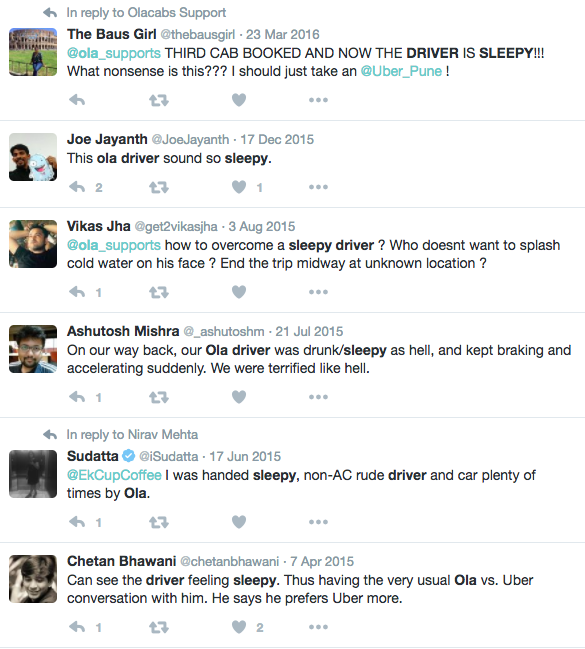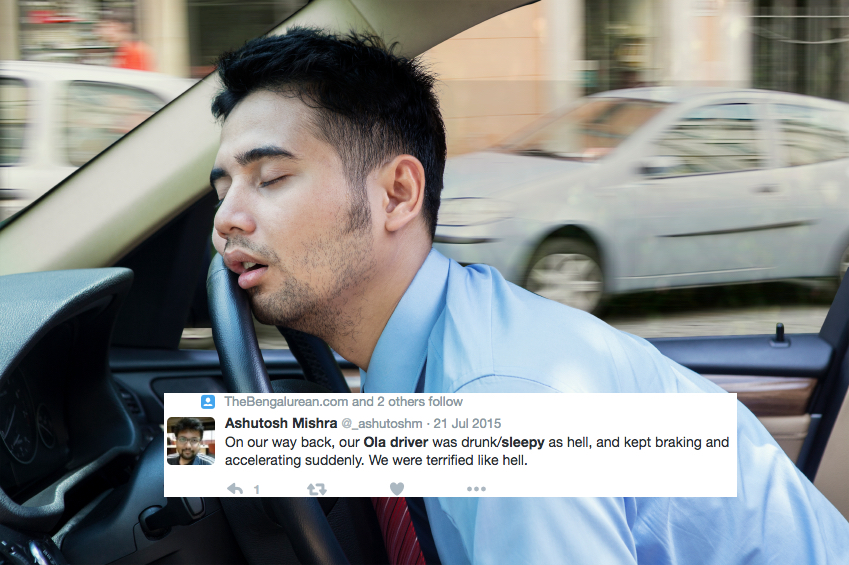On 15th May last year, Ishaan Gill from Delhi had an unusual Uber ride.
Gill had sensed something was amiss when the ride had started. “The cab reached an hour late and the driver Ajay seemed dizzy. I asked him if he was OK and he nodded in positive. At Aurobindo Marg, I stopped texting and looked ahead on the road. To my amazement, the driver was about to hit a divider. As I looked towards him, he had completely dozed off,” he wrote in a Facebook post. The driver told him that he’d taken pills to keep himself awake.
Gill ended up driving his Uber home himself. His driver slept in the passenger seat. When Gill reached home, he left a Rs. 500 note in the drivers lap and walked away.
More worryingly, Gill’s situation isn’t all that unusual. Twitter’s littered with people complaining of sleepy Uber and Ola drivers. And the problem’s international – last month, a driver had sued a passenger for taking over the wheel when he was sleepy, and subsequently crashing his car. Vice reported on a US driver who was driving 18 hours a day in her Uber.

And in India, Uber and Ola drivers are regularly fighting sleep as they zoom across cities in increasingly large numbers. And it’s not just that they’re eager to make more money through rides – Uber and Ola’s incentive structure disproportionately rewards drivers who complete a certain number of trips in a day.
Ola, for instance, rewards its drivers Rs. 3700 if they complete 12 rides in a day – over and above the earned fares. This rises rapidly to Rs. 4700 for 15 rides, and to Rs. 6700 for 18 rides. Uber, too, has a similar structure, where drivers earn progressively higher amounts for fares earned.
The tiered system incentivizes drivers to push themselves into the next tier, even if their bodies are groaning in protest. After a long day with 17 rides, a driver realizes that he stands to make an extra Rs. 2000 if they finish just one last ride – and they often decide against their better judgement to do so.
The squeeze on driver earnings isn’t helping. Both Uber and Ola have cut incentives, making bonuses and base fares even harder to attain. Drivers who’d taken loans to purchase cars are finding it increasingly difficult to pay them off; tensions spilled over in Hyderabad recently when drivers went on a 5 day strike.
This is a dangerous situation – the lowered earnings, the proliferation of Uber and Ola, and increasingly desperate drivers are combining to create a dangerous powder keg that’s making Indian roads decidedly unsafe. Most Indian cities now have cab aggregator drivers that number in the tens of thousands – for them to be sleep deprived behind the wheel is a disaster waiting to happen.
And what’s infuriating is that the solution is staring cab aggregators in the face – prevent drivers from driving more than a certain number of hours in a day. Uber’s competitor Lyft already implements this in the US – the app doesn’t let drivers drive for more than 14 hours in a day. The Karnataka government had suggested something along the same lines while drafting its Cab Aggregator Policy, but had been met with protests from drivers.
Uber and Ola could argue that normal taxis don’t have a cap on the number of hours a driver can drive, but Uber and Ola aren’t exactly normal taxis – their incentive structure expressly pushes drivers to complete more rides than they’re comfortable with. And Uber and Ola have the means to provide a higher level of safety and service – all it would take is a simple update to their app to make sure that drivers can’t drive beyond a certain number of hours a day. Uber and Ola already provide more reliability, better fares, and more convenience than regular taxis. They need to ensure that they provide more safety than normal taxis too.
It’ll be the responsible thing to do.
